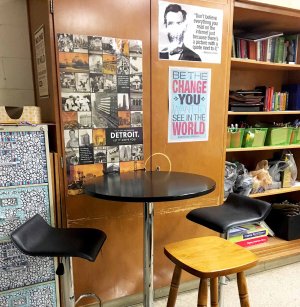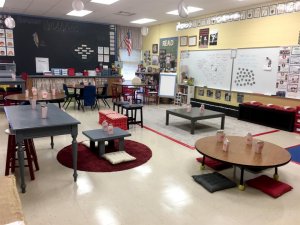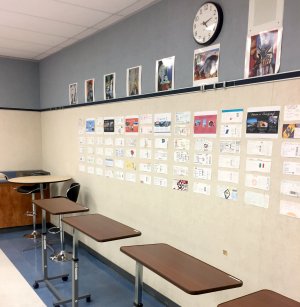Dos and Don’ts of Classroom Decorations
What you put on your classroom walls can affect your students’ ability to learn.
Heavily decorated classrooms can bombard students with too much visual information, interfering with their memory and ability to focus, a new study finds.
This is just the latest study to examine the relationship between classroom environment and students’ executive functions, which include skills like memory, attention, and self-regulation. While teachers have good intentions when decorating, many classrooms end up being “sensory-rich” in a way that “could hamper children’s learning gains rather than help,” according to psychologists Pedro Rodrigues and Josefa Pandeirada, who coauthored the study.
To understand how decorations affect learning, Rodrigues and Pandeirada recruited 64 children between 8 and 12 years old to perform attention and memory tasks in two groups. For the high-decoration group, the walls of the room were covered with numerous pictures of ordinary objects and scenes, such as cars, musical instruments, and trees. Walls in the control group’s room, on the other hand, were bare.

The children performed a series of tasks designed to test their attention and memory. In one attention test, for example, they observed a laptop screen, pressing a button if an X appeared and doing nothing if a K appeared. In a memory test reminiscent of the electronic game Simon Says, the children observed nine blue squares that changed to yellow in varying sequences, which the children attempted to repeat. A total of four tests were given—two for memory and two for attention.
Compared to children in the bare-wall room, children in the high-decoration room performed worse on all tests, which suggests that too much visual stimulus can be a distraction.
“Overall, the results from these studies indicate that children could have difficulty in ignoring visual distractors when these are embedded in the surrounding environment,” the study authors explain.
Classrooms Should Be Engaging, Not Distracting
That’s not to say that every wall must be bare. In 2015, a team of researchers in the U.K. analyzed 153 classrooms and found that students benefited most when the walls had some decorations. “The displays on the walls should be designed to provide a lively sense to the classroom, but without becoming chaotic in feel. As a rule of thumb, 20 to 50 percent of the available wall space should be kept clear,” the researchers wrote.
So what do researchers say teachers should do?
- Display student work. Students not only feel a greater sense of responsibility for their learning but are also more likely to remember the material (Barrett et al., 2015).
- Feature inspiring role models. Putting up images—and short stories or quotes—featuring heroes and leaders can help students gain a greater sense of belonging and aspiration, especially when their backgrounds and interests are represented. Strive for inclusion, but avoid token or stereotypical representations—they can be damaging to students’ self-esteem (Cheryan et al., 2014).
- Avoid clutter. Keep at least 20 percent of your wall space clear, and leave ample space between displays so they don’t look disorganized. Resist the temptation to keep adding decorations—it’s better to swap them out than to keep adding more (Barrett et al., 2015).
- Visual aids—like anchor charts, maps, and diagrams—are OK. Posters that reinforce a lesson, rather than distract from it, can boost student learning. But don’t forget to take down ones that are no longer helpful (Carney & Levin, 2002; Bui & McDaniel, 2015).
- Avoid displays of student scores or grades. Many teachers use data walls to motivate students, and while they can work for high performers, they can backfire for struggling students, leading to feelings of shame and demoralization (Marsh et al., 2014).
- Let in natural light. Don’t cover up your windows with decorations unless you have a problem with glare or outside distractions. Students who are exposed to more natural light in their classrooms outperform peers who get less natural light in math and reading (Cheryan et al., 2014). If you don’t have windows, making sure the room is well lit can boost achievement (Barrett et al., 2015).
- Balance wall colors. You don’t have to stick with four white walls—try having a single feature wall painted a bright color, with the rest being muted (Barrett et al., 2015).
Developing Brains
While decorating walls is a favorite pastime for many teachers, young children may not respond as teachers hope.

“Our findings could be related to the fact that children’s cognitive capacities are still under development, including executive functions responsible for the filtering of irrelevant information for a given task,” explain the study authors. A teacher may have little difficulty ignoring a wall full of decorations, but young students may find themselves unable to look away and focus on a lesson.
Children aren’t born with fully developed executive functions—they have to develop these skills over time, according to Harvard’s Center on the Developing Child. Children who have adverse experiences—such as neglect, abuse, or violence—or learning disabilities are at greater risk of impaired attention and self-regulation skills. So classroom distractions may be harming the students who need the most help.
The Third Teacher

This study is the latest in an emerging field looking at classrooms as the third teacher—after parents and the teacher—which views the environment as essential to supporting learning. The idea is hardly new; approaches such as Reggio Emilia and Montessori put it at the forefront of pedagogy, giving classrooms a prominent role in shaping how students learn. Recent studies have shown evidence for the role that classrooms play in learning: A 2014 study, for example, found that young students spent more time off-task when classroom walls were highly decorated, while research on flexible classrooms shows that optimizing physical characteristics of classrooms such as light, color, and seating options can improve academic performance by as much as 16 percent.
The takeaway: Classroom walls should feel warm and lively but not overcrowded—keep 20 to 50 percent of the wall space clear, and fill the rest with student work, inspiring pictures, and learning aids.
